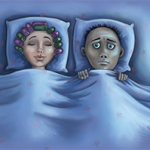Though most of my patients are not jet-setters, one does not have to look too far to recognize the impact of normal and altered circadian rhythms on selected rheumatologic diseases. Perhaps the paradigm disease would be gouty arthritis, particularly podagra. As Thomas Sydenham observed in 1683, “The victim goes to bed and sleeps in good health. About two o’clock in the morning, he is awakened by a severe pain in the great toe.”5
Another example is the quotidian fever curve observed in patients with adult Still’s disease. As fellows, we were taught to always check in on our patients with Still’s disease during the mid to late afternoon, when the likelihood was greatest for witnessing the characteristic salmon-colored rash that heralded their fever spike. Of course, morning stiffness is so highly characteristic of polymyalgia rheumatica or ankylosing spondylitis that its absence from the history of a patient suspected of having either diagnosis essentially rules out these conditions.
Circadian Cytokines
What might tie circadian rhythmicity to these inflammatory diseases? The first clues began to emerge following the discovery of cortisol. Researchers identified a circadian rhythm involving the hypothalamus–pituitary–adrenal axis that generated a maximal cortisol secretion peak around 8:00 AM and a nadir around midnight. When graphing the relationship between cortisol levels and time of day in healthy individuals, a single sharp peak is observed. However in patients with severe rheumatoid arthritis (RA), this peak is flattened and replaced by two peaks, one in the morning and the other in the afternoon.6 Following the discovery of the critical roles played by tumor necrosis factor (TNF) and interleukin (IL) 6 in the pathogenesis of RA, their circadian rhythms were also noted to differ from those of healthy controls. In patients with RA, the peak level of TNF appears around 6:00 AM and that of IL-6 at 7:00 AM, indicating a delay of three and one hours, respectively. In healthy subjects, serum levels of TNF and IL-6 start to decline by 6:00 AM and 9:00 AM, respectively, whereas in RA patients, elevated levels persist for several more hours. More importantly, the height of the secretion curves for these two cytokines is about twentyfold greater than in controls. Using a mouse model of systemic inflammation, researchers concluded that secretion of TNF-alpha can interfere with the expression of circadian rhythm–related genes, impair locomotor activity, and enhance the proclivity for rodents to rest.7 Might a similar situation be at play in RA?

